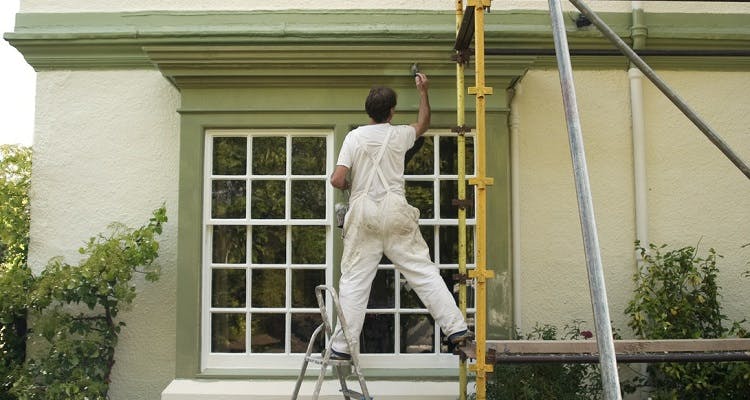
Are the exterior walls of your home looking tired and dirty?
Are there cracks in the masonry? Are they starting to cause issues with dampness and mould?
Are your beautiful timber window frames and doors starting to flake and go rotten?
If so, you may need to look at repairing and repainting these areas to protect your home.
Let’s look at the symptoms in more detail:
Blistering/bubbling

If the paint on the exterior of your home is starting to blister and bubble like this, then it means moisture is getting behind the paint and pushing it off.
There are several causes for the moisture getting behind the paint. It could be moisture coming from within the property, it could be coming in via cracks in the masonry, rising damp due to an ineffective damp proof course or even rainwater penetrating through the ageing paint.
A professional decorator will be able to assist in identifying the cause of the issue.
This would need to be dealt with sooner rather than later as once these blisters/bubbles begin to burst and peel off, it will leave the surface exposed and will exacerbate the problem.
Chalking

When paint starts chalking like this it means that the resin in the paint has started breaking down. This is typically caused by UV light from the sun.
Essentially, the resin is the glue that holds all the other paint ingredients together.
Once the resin breaks down, the powders and pigments are no longer being held together. So, they simply turn back to a fine powder.
Some paints are more resistant to UV breakdown than others but over time this will happen to all paints.
When paint starts chalking then it is at the end of its life cycle and needs to be re-done. Otherwise, the paint then starts to come off and leaves the surface underneath exposed.
It is common to see this sort of thing on garage doors that have been neglected, as well as masonry surfaces.
Cracks or blown render

Cracks and blown render are typically caused by rainwater penetrating a wall, then expanding through freezing/thawing.
Running a ring spanner across your masonry is a quick and easy way to identify blown render. Any areas that sound hollow have ‘blown’. Which essentially means the render has come away from the surface underneath.
Repairing cracks and blown render is essential to maintaining your property and should be done before any painting takes place. Otherwise, water will still be able to get in behind the paint and cause issues.
Peeling/flaking

If your paint starts looking like this then it means, there is an issue with the adhesion. (The paint has not stuck to the surface properly).
This can be caused by several things. Including incorrect products being used or the surface was dirty or dusty before the paint was applied.
Dealing with this promptly will ensure your property does not remain exposed to further weather damage.
Mould / Dirt pick up

If you notice mould or high dirt pick up on a painted surface then you need to rectify the situation.
Organic growth, such as mould, algae and lichen need moisture to survive and grow. So, if you have this on your walls then it means the surface has become porous and is holding moisture.
This is a good sign that the paint is coming towards the end of its life and needs to be re-done.
Rotten windows and doors

When moisture gets into wooden doors and window frames it can cause a lot of damage. Including making them go rotten. Regular maintenance is the best way to stop this from happening and avoid having to replace all your windows and doors.
Faded colour

Another issue caused by UV light from the Sun is colour fading. Certain pigments in the paint can fade over time, and depending on which areas of your home get more sunlight than others you can start to see areas becoming patchy.
Investing in higher quality paints can reduce this issue.
What other benefits are there to painting the exterior of your home?
Painting the exterior of your home doesn’t just protect against these issues, it can also transform the look.
This gives your home 'kerb appeal'
This can be brilliant for the value of your property…plus it’ll make the neighbours jealous.
Summary:
More often than not, prevention is cheaper than cure.
So, regular maintenance to the exterior of your home is essential.


